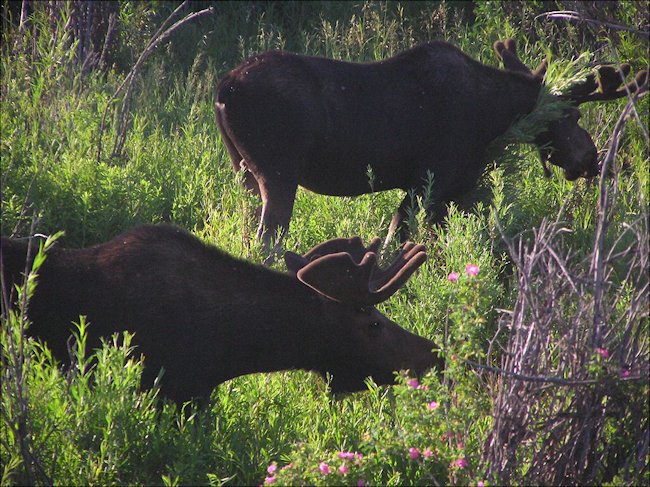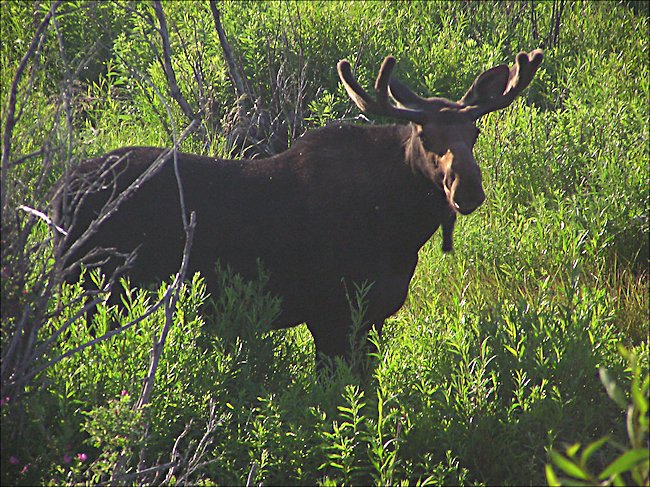Grand Teton National Park Moose
Grand Teton National Park has a large amount of Moose in the park grounds free to roam where ever they want. On my last visit most of my sightings of moose was near the river beds early in the morning. As the sun rose in the sky they moved to the welcome shade of the forest.

To have the best chance of sighting moose get out of your car and find a comfortable spot to sit near a river by a forest in the early morning or just before dusk. Just like in Africa the best time to see animals is dawn. You are going to have to get up in the dark, grab a coffee and head for the river. You can have breakfast later. If you have been successful and spotted wildlife you will have a lot to talk about over your bacon pancakes and maple syrup later.
Now this is confusing. In Europe Moose are called Elk but in North America an Elk is the name of a large deer. Moose can be found in Alaska and across the length of Canada except in the very far north. There are healthy, growing populations in the wilderness areas of the US states of Maine, New York, Rhode Island, Connecticut, Massachusetts, Vermont and New Hampshire. There is a big population of Moose in the Rockie Mountains of Wyoming, Idaho and Montana. There is even a small settlement in Grand Teton National Park called Moose WY.
Moose eat many types of plants and fruits which makes them herbivores. They need to consume just under 10,000 calories, 32 kg of food, per day to maintain its body weight. That is an awful lot of food to find and eat each day. Moose love munching on fresh shoots from trees such as willow and birch. They eat a lot of grass. This type of food is rather low in sodium, an element that they need, so moose also have to feast on a lot of aquatic plants. This is why you will see them along the banks of rivers. Half of a Moose's diet usually consists of aquatic plant life. In the winter you will often see moose near highways because of the salt spread on the road. They like to lick the salt off the road as they try to get their daily dose of sodium in the form of salt.

Have a look when a Moose is eating. They do not have any upper front teeth. On their lower jaw Moose have eight sharp incisors for ripping off leaves and cutting grass. A very tough tongue, lips and gums, help the moose eat and grind up woody vegetation.
Antlers are mainly used for display to attract females and for fighting other males over mating rights. The bull Moose antlers fall off after the mating season. The scientists believe that it helps conserve energy for the winter. Antlers re-grow in the spring and about take three to five months to fully develop. When they are growing they are covered in a layer of protective velvet skin. This is shed once the antlers become fully grown. Some times you will see the male’s rubbing their antlers against tree trunks to help speed up the process. Some immature bulls do not shed their antlers for the winter, but retain them until the following spring.
The Moose is the second largest land animal in both North America. The Bison is the largest. Apart from man and the few areas where wolves have been reintroduced the Moose has few predators. They are most vulnerable when they are very young. They have a life span on average about 15 to 25 years. The mating season is the best time to see Moose in groups as they are normally solitary. Calves are born in May and June after an eight month gestation period. The females give birth to one or two calves that stay with their mother until the following May.
Do not get too close to any Moose you come across in Grand Teton NP. They will charge humans if provoked or frightened. Normally they are passive but they should be treated with respect as they are incredibly large animals that can do a lot of damage. They do not view humans as food so will not normally pursue them like wolves if they run away. Too many visitors to Grand Teton have been injured trying to feed or stroke them. Give Moose space.
When you are driving around the national park be very careful that you do not drive to fast. You need to be able to stop in time if a Moose decides to cross the road in front of you. High speed car v Moose road traffic accidents are normally fatal, both for the animal, vehicle driver and front seat passenger. It's body goes though the windscreen and because it is so heavy it smashes the roof supports and brings the roof down onto the occupants.
Travel books

